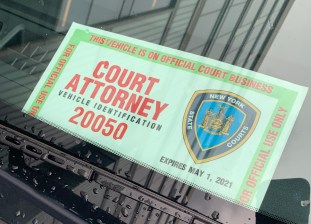The Parking Cure Part 2: Do the Right Tests
We continue with our look at recommendations proposed in "Suburbanizing the City," a report issued by a cross-section of public interest groups on the detrimental effects of off-street parking policies on city traffic.
 Last week we visited the city’s parking doctor and got the
Last week we visited the city’s parking doctor and got the
wrong medicine. In this episode of city parking malpractice, the
parking doctor is doing the wrong tests.
In Manhattan
south of 60th Street,
new off-street parking is allowed only by special permits issued by the City
Planning Commission. This rule is the main transportation legacy of the federal
Clean Air Act in New York City. It
stems from a long-running legal challenge from environmentalists dating back to
the late 1970s. The rule has resulted in the Manhattan Central Business
District having one of the lowest ratios of parking to people in the developed
world.
Unfortunately, this success story is being swamped by a wave
of accessory parking in new residential towers. According to Lindsey Lusher at
Transportation Alternatives, city records indicate new parking in the Clean Air
Act zone is being built at a record pace. It turns out that the City Planning
Commission, with the consent of the Manhattan Borough President, "can" grant
special permits for new parking in the Clean Air Zone. However, due to court
decisions and political pressure from real estate developers, the planning commission has approved hundreds, perhaps thousands, of special permits, and attempted
to disapprove only a handful.
A key legal reason for this promiscuous
permitting is the strange way New York City’s
environmental laws are interpreted when it comes to parking. Each new parking
garage is considered in isolation from its neighbors. Because of this, the
coalition of environmental and planning groups which released the "Suburbanizing the City" parking report asked the mayor to change the
environmental review process for parking.
2. Revise
environmental rules so that parking impacts are fully accounted for.We recommend that the
city revise CEQR rules for the special permitting process so that the
cumulative impact of new parking garages on neighborhoods is considered. Currently,
the impacts of a new parking garage are considered in isolation from impacts of
other new parking garages. The cumulative impact of large amounts of parking
are not considered, and overall impact of additional traffic on neighborhoods
is ignored. For example, in Hells Kitchen in Midtown Manhattan, thousands of
new residential parking spaces have been added in recent years. Yet, there has
been no assessment of the cumulative traffic or environmental impact. Impacts
of each new garage are assessed only if the garage generates 50 or more car trips
in a peak hour. The problem with this approach is that two or more nearby garages
could generate many more than 50 cars per hour, even though each individual
garage would not. The net result of this approach is that very large traffic
impacts are being ignored. One way for the City to deal with this issue would be to set
a maximum number of parking spaces that would be environmentally acceptable, based on an environmental review, for
each area of the city. These
environmental reviews would consider cumulative effects. Once the maximums are set, special permits
would be granted only if the total number of parking spaces within each area
remained below the maximum acceptable number.
The groups know full-well that revising CEQR is a major undertaking. But an environmental law this myopic and ineffectual does little to further the public good and must be changed.
Photo of Chelsea traffic by ATHLETE Director Dave/Flickr
